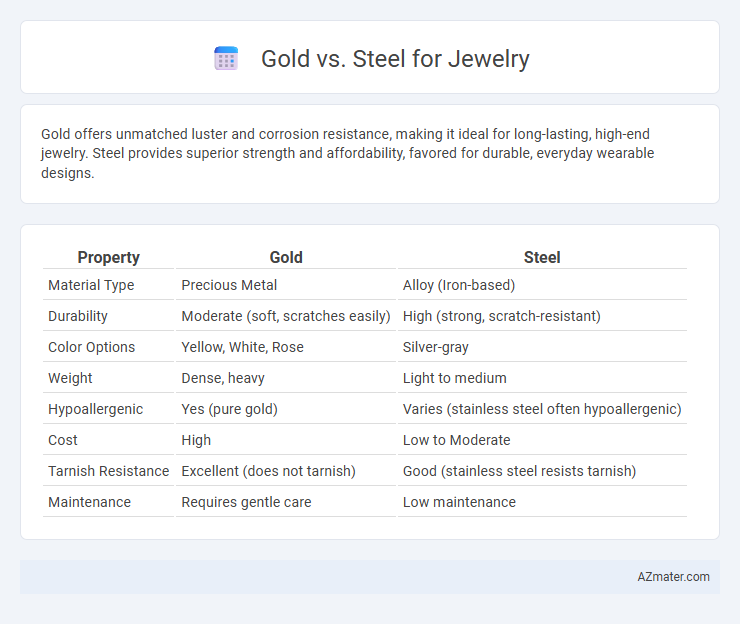Gold offers unmatched luster and corrosion resistance, making it ideal for long-lasting, high-end jewelry. Steel provides superior strength and affordability, favored for durable, everyday wearable designs.
Table of Comparison
| Property | Gold | Steel |
|---|---|---|
| Material Type | Precious Metal | Alloy (Iron-based) |
| Durability | Moderate (soft, scratches easily) | High (strong, scratch-resistant) |
| Color Options | Yellow, White, Rose | Silver-gray |
| Weight | Dense, heavy | Light to medium |
| Hypoallergenic | Yes (pure gold) | Varies (stainless steel often hypoallergenic) |
| Cost | High | Low to Moderate |
| Tarnish Resistance | Excellent (does not tarnish) | Good (stainless steel resists tarnish) |
| Maintenance | Requires gentle care | Low maintenance |
Introduction: Gold vs Steel in Jewelry
Gold and steel are two prominent materials used in jewelry, each offering distinct advantages and aesthetics. Gold is prized for its timeless appeal, malleability, and resistance to tarnish, making it ideal for luxury and heirloom pieces. Steel, particularly stainless steel, provides durability, affordability, and a modern, sleek appearance favored in everyday and fashion jewelry.
Material Composition and Properties
Gold jewelry primarily consists of a gold alloy containing pure gold mixed with metals like copper, silver, or zinc to enhance durability and color, typically measured in karats such as 18K or 14K. Steel jewelry is mainly made from stainless steel, an alloy of iron, carbon, and chromium, offering high corrosion resistance, strength, and hypoallergenic properties. The intrinsic softness of gold allows for intricate designs but makes it prone to scratches, whereas steel's hardness ensures superior scratch resistance and long-lasting wear.
Durability and Strength Comparison
Gold, while valued for its luster and malleability, is significantly softer and less durable than steel, making it more prone to scratches and deformation in everyday wear. Steel, particularly stainless steel, offers superior strength and resistance to corrosion, providing enhanced durability and longevity for jewelry pieces exposed to daily rough use. The hardness of steel also ensures better retention of shape and finish compared to gold, which may require more frequent maintenance to preserve its appearance.
Aesthetic Appeal and Finish
Gold jewelry offers a warm, luxurious glow with a rich, glossy finish that enhances its timeless elegance, making it ideal for classic and high-end designs. Steel jewelry provides a sleek, modern aesthetic with a polished or matte finish, known for its durability and resistance to tarnish, appealing to contemporary styles. The choice between gold and steel hinges on desired color tone, surface texture, and the statement piece's overall visual impact.
Hypoallergenic and Skin Sensitivity Factors
Gold jewelry, especially in higher karats like 18K or 24K, tends to be more hypoallergenic due to its minimal alloy content, making it ideal for sensitive skin. Steel, particularly surgical-grade stainless steel, is also hypoallergenic and resistant to tarnish and corrosion, providing a durable and skin-friendly option for those prone to allergies. Both metals offer excellent choices for sensitive skin, but individuals with extreme sensitivity may prefer high-purity gold to minimize the risk of irritation.
Maintenance and Care Requirements
Gold jewelry requires regular polishing to maintain its shine and is less prone to tarnish, though it can scratch more easily depending on its karat purity. Steel jewelry, especially stainless steel, offers superior durability and resistance to scratches, tarnish, and corrosion, demanding minimal maintenance beyond occasional cleaning with mild soap and water. Choosing between gold and steel depends on balancing the ease of upkeep with desired appearance and scratch resistance.
Cost and Affordability Differences
Gold jewelry typically costs significantly more than steel due to its rarity, purity, and intrinsic value, with prices fluctuating based on the gold market and karat weight. Steel jewelry offers a highly affordable alternative, balancing durability and style without the premium price tag associated with precious metals. Consumers seeking cost-effective options often favor steel, while those prioritizing investment value and prestige lean towards gold.
Popularity and Fashion Trends
Gold remains the most popular choice for jewelry due to its timeless appeal, intrinsic value, and association with luxury, making it a staple in both classic and contemporary fashion trends. Steel jewelry, particularly stainless steel, has surged in popularity for its durability, affordability, and ability to mimic precious metals, appealing to younger, fashion-forward consumers. Current trends show a growing preference for mixed-metal designs, combining the elegance of gold with the modern edge of steel to create versatile, statement pieces.
Environmental Impact and Sustainability
Gold mining generates significant environmental damage, including habitat destruction, water pollution, and high carbon emissions due to energy-intensive extraction processes. Steel, often recycled and produced with increasing use of electric arc furnaces, generally has a lower environmental footprint and greater sustainability potential in jewelry manufacturing. Choosing recycled steel over newly mined gold substantially reduces resource depletion and greenhouse gas emissions, making it a more eco-friendly option for sustainable jewelry.
Choosing the Right Metal for Your Jewelry
Choosing between gold and steel for jewelry depends on durability, style, and skin sensitivity. Gold offers timeless elegance, hypoallergenic properties, and various karat options, ideal for formal pieces and everyday wear. Steel provides a modern, budget-friendly alternative with exceptional strength and resistance to tarnish, making it perfect for active lifestyles and contemporary designs.

Infographic: Gold vs Steel for Jewelry
 azmater.com
azmater.com